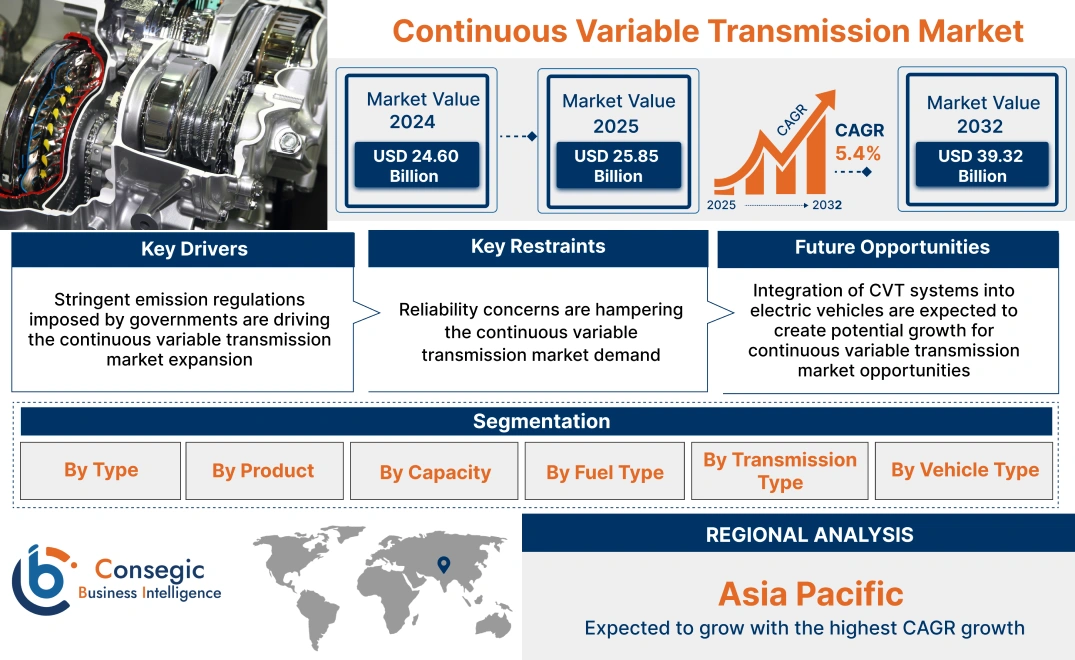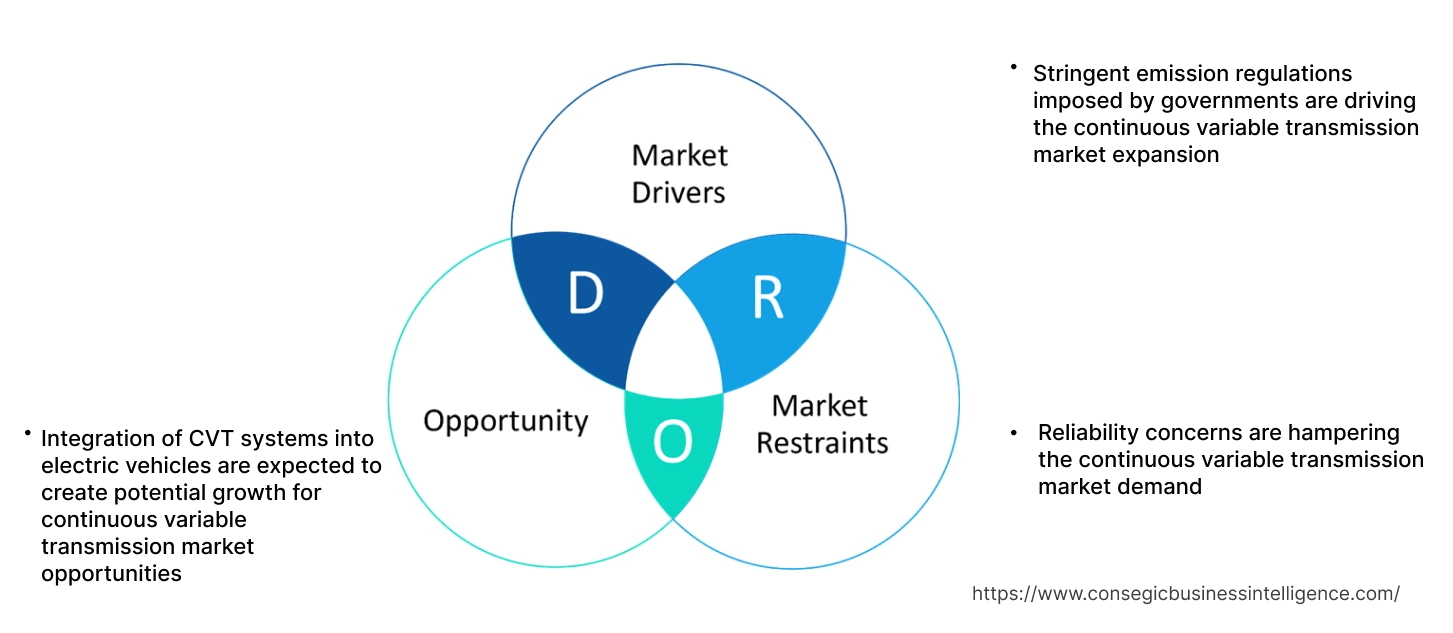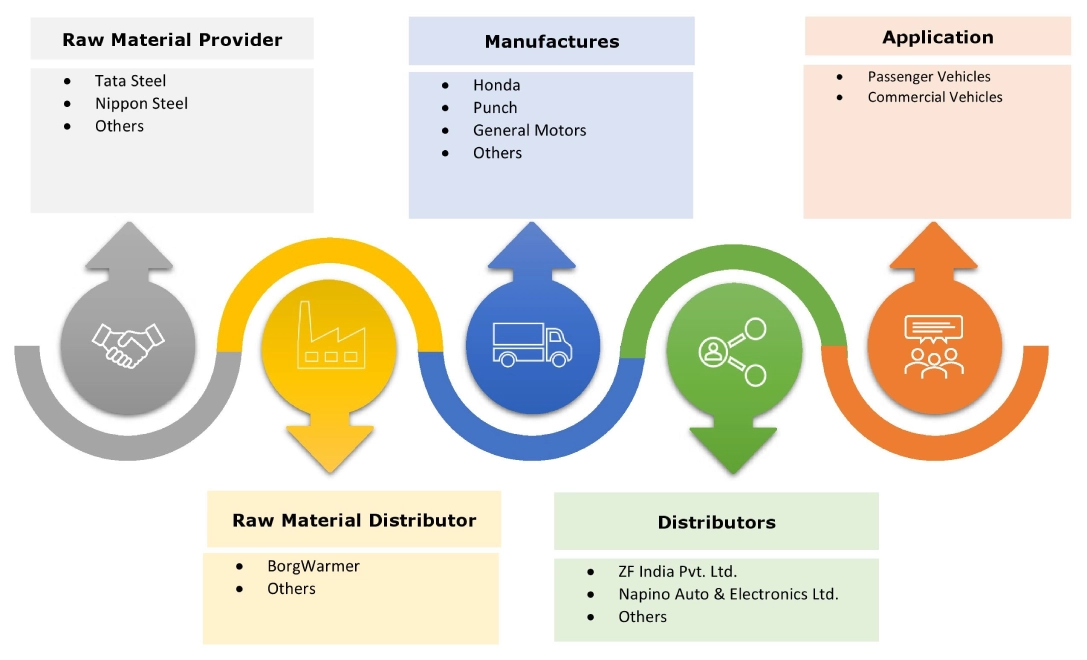- Summary
- Table Of Content
- Methodology
Continuous Variable Transmission Market Size:
Continuous Variable Transmission Market Size is estimated to reach over USD 39.32 Billion by 2032 from a value of USD 24.60 Billion in 2024 and is projected to grow by USD 25.85 Billion in 2025, growing at a CAGR of 5.4% from 2025 to 2032.
Continuous Variable Transmission Market Scope & Overview:
Continuous variable transmission systems provide smooth acceleration and enhanced fuel efficiency relative to traditional automatic or manual transmissions, leading to their growing popularity among consumers and automotive manufacturers. Additionally, global emission regulations have accelerated the adoption of these variable transmission systems, as they facilitate lower carbon emissions through their efficient power delivery mechanisms. Further, ongoing initiatives by manufacturers to improve vehicle transmission systems performance, lower costs, and resolve reliability concerns are expected to drive market growth in the upcoming years, as the automotive sector is progressing towards more sustainable and efficient drivetrain technologies.
Key Drivers:
Stringent emission regulations imposed by governments are driving the continuous variable transmission market expansion
The stringent regulations by various governments are sought to reduce greenhouse gas emissions and enhance air quality, necessitating that automakers implement more fuel-efficient technologies.
The stringent regulations imposed by various governments aim to reduce greenhouse gas emissions and improve air quality which in turn requires automakers to adopt more fuel-efficient technologies. Continuous Variable Transmission (CVT) systems provide superior fuel efficiency compared to traditional transmissions, allowing vehicles to operate more effectively and produce fewer pollutants. Consequently, automotive manufacturers are progressively integrating variable transmission technology into their vehicle designs to comply with regulatory requirements and lessen their environmental impact.
Moreover, the increasing focus on sustainability and corporate social responsibility has further accelerated the adoption of CVT systems within the automotive sector. Consumers are increasingly prioritizing eco-friendly vehicles that reduce their carbon footprint, prompting automakers to invest in technologies that improve fuel efficiency and lower emissions. These systems are crucial in optimizing engine performance and maximizing fuel economy, aligning with the sustainability aspirations of both consumers and manufacturers.
- For instance, Eaton has announced that the company would focus on CO2 and NOX emissions, with the intent of reducing the impact of greenhouse gas emissions on climate. To change this paradigm, Eaton has recently launched standalone heating units for emissions aftertreatment systems. These heaters rapidly elevate the temperature of the catalyst component while the engine is still cold, enhancing the system's efficiency in processing and reducing NOx in the exhaust stream.
Thus, according to the continuous variable transmission market analysis, these developments and trends are driving the continuous variable transmission market size.
Key Restraints:
Reliability concerns are hampering the continuous variable transmission market demand
Despite technological advancements, consumers still harbor concerns about the durability and long-term performance of vehicle transmission systems. Several factors such as belt and pulley wear, overheating, and limited towing capacity have contributed to a perception of reduced reliability compared to traditional transmission systems. It is essential for manufacturers to address these concerns to boost consumer confidence and promote the wider adoption of CVT technology. To alleviate reliability issues, manufacturers have been actively investing in research and development aimed at enhancing durability and performance. Further, the implementation of improved materials, advanced cooling systems, and optimized designs aims to extend the lifespan of CVT components and decrease the likelihood of failures. Furthermore, rigorous testing and quality control measures are being employed to detect and resolve potential reliability issues during the development phase, ensuring that these systems adhere to strict performance standards and can endure real-world driving conditions. These factors and analysis are progressing of the continuous variable transmission market trends.
Future Opportunities :
Integration of CVT systems into electric vehicles are expected to create potential growth for continuous variable transmission market opportunities
As the transition to electrification accelerates, the manufacturers can utilize their expertise in transmission technology to create specialized solutions that address the specific needs of electric powertrains. Unlike traditional internal combustion engine vehicles, electric motors provide instantaneous torque, necessitating transmission systems capable of effectively managing power delivery across a wide speed range. Continuous variable transmissions with potential of continuously adjusting gear ratios, can optimize power delivery and enhance efficiency in electric vehicles leading to smoother acceleration and improved energy utilization. With the global electric vehicle market rapidly expanding, there is an increasing demand for transmission systems that can support the varied requirements of electric mobility. CVT manufacturers can capitalize on this development by developing innovative transmission solutions that fulfill the performance, efficiency, and spatial requirements of electric vehicles. By aligning their product development strategies with the evolving demands of the electric vehicle market, the manufacturers can establish themselves as essential contributors to the advancement of sustainable transportation technologies while unlocking new growth opportunities in the automotive sector.
- For instance, in March 2024, Subaru Corporation announced the collaboration with Aisin Corporation, to develop and split production of eAxels 1 to utilize in battery electric vehicles. With this collaboration, Subaru would layout a roadmap for 2050 and is expediting its electrification initiatives, while Aisin aims to foster a carbon-neutral society through advancements in production and products, accelerating the development of eAxle.
Thus, based on the above analysis, these factors and developments are driving the continuous variable transmission market opportunities.
Continuous Variable Transmission Market Segmental Analysis :
By Type:
Based on the type, the market is segmented into hydrostatic, toroidal, cone, variable geometry, and variable diameter
Trends in the type:
- Continuous variable transmission enhances fuel efficiency by continuously modifying the gear ratio to maintain optimal engine speed, resulting in decreased emissions and lower fuel expenses.
- Continuous research and development are yielding advancements transmission technology, including greater durability, reduced noise, and enhanced performance.
The hydrostatic segment accounted for the largest revenue in the year 2024 and is expected to register the highest CAGR during the forecast period.
- The growing demand for heavy machinery and equipment in construction projects has elevated the market for hydrostatic transmissions, which are widely utilized in construction equipment such as loaders, bulldozers, and excavators.
- Hydrostatic transmissions offer several advantages over other transmission types, including improved fuel efficiency, effective power delivery, and smoother operation, thereby making them an attractive choice for construction companies.
- For instance, Bosch’s multispeed transmission concept aimed at applications in electric vehicles, which is designed to fulfil performance requirements for a broader audience. This solution offers economic and performance advantages in electric powertrains while ensuring a smooth driving experience.
- These factors and developments would further drive the continuous variable transmission market size during the forecast period.
By Product:
Based on the product, the market is segmented into belt and pulley transmission and chain-driven transmission.
Trends in the product:
- The vehicle transmission systems are optimal for hybrid and electric vehicles, enhancing their efficiency and performance. This trend benefits both chain and belt-driven transmission systems
- Manufacturers are prioritizing weight reduction in transmission technology to boost fuel efficiency and overall vehicle performance, applicable to both product types.
The chain-driven segment accounted for the largest revenue share of 57.80% in the year 2024.
- Chain-driven transmissions use a metal chain to transmit power from the engine to the wheels, providing strong performance and durability. They are commonly selected for heavy-duty applications and high-performance vehicles, where reliability and efficiency in power transmission are essential.
- Chain-driven transmissions are preferred in contexts where strength and torque capacity are vital, such as in trucks and SUVs.
The belt and pulley transmission segment is anticipated to register the fastest CAGR during the forecast period.
- Belt-and-pulley transmissions utilize a system of belts and pulleys to smoothly adjust the gear ratio, enhancing acceleration and fuel efficiency. This type of continuously variable transmission is frequently used in passenger vehicles due to its lightweight construction and affordability.
- Belt-and-pulley transmissions are superior in delivering a smoother driving experience and improved fuel economy, making them well-suited for compact and hybrid cars.
- The growing emphasis on fuel efficiency and lower emissions is propelling the adoption of advanced belt and pulley systems that reduce power losses and enhance engine efficiency.
- The worldwide rise in vehicle production, especially in emerging markets, is generating significant demand for automotive components, such as belt and pulley systems.
- For instance, in March 2021, Gates launched X9 synchronous drive belt. This belt is specifically engineered for two-wheelers, such as electric motorcycles and scooters and internal combustion motorcycles. The belt is also more robust and reliable than competing synchronous belts, providing OEMs the potential for more compact, lightweight drivetrain packaging and improved vehicle performance.
- These factors would further supplement the continuous variable transmission market trends during the forecast period.
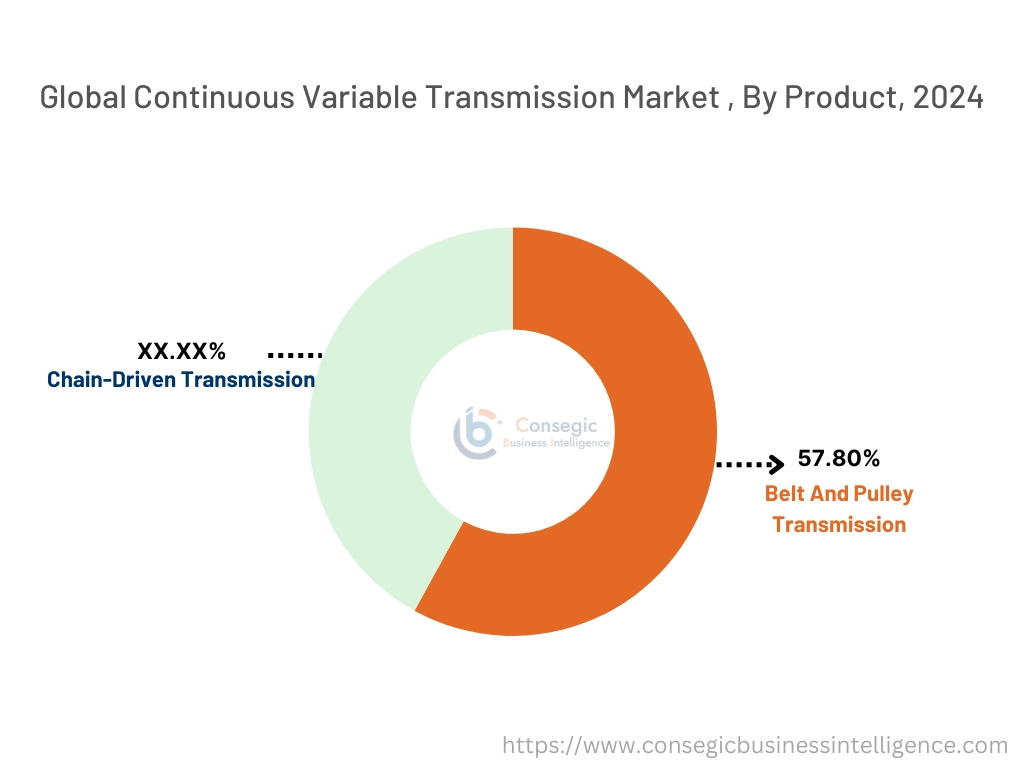
By Capacity:
Based on the capacity, the market is segmented into Up to 1.5 L, 5 L to 3.0 L, and above 3.0 L.
Trends in the capacity:
- High-performance vehicles and larger SUVs require a combination of power and efficiency. Continuously variable transmissions provide seamless power delivery while ensuring favorable fuel economy.
- The growing demand for compact and subcompact cars in emerging markets significantly driving the global market.
Up to 1.5 L segment is dominating the market and is expected to register the highest CAGR during the forecast period.
- Up to 1.5 L category typically includes compact and subcompact vehicles, where fuel efficiency and cost-effectiveness are crucial. Variable transmission in this segment is preferred for their capability to enhance engine performance in smaller displacement vehicles, providing smooth acceleration and improved fuel economy, which resonates with the needs of budget-conscious consumers and urban commuters.
- For 1.5 L capacity, continuous variable transmission is generally simpler and less costly to produce than traditional automatic transmissions with multiple gears. This results in reduced production costs for automakers.
- These factors would further supplement the continuous variable transmission market during the forecast period.
By Fuel Type:
Based on the fuel type, the market is segmented into gasoline, diesel, and hybrid.
Trends in the fuel type:
- Stringent government regulations focused on minimizing fuel consumption and emissions are propelling the advancement of more efficient transmissions across various fuel types.
- Consumers are placing greater emphasis on fuel economy and performance, leading to increased requirement for vehicles featuring advanced transmission systems.
Gasoline segment accounted for the largest revenue share in the year 2024.
- Vehicles that operate on gasoline comply with nearly all pollution standards. Furthermore, they are more efficient and produce fewer toxic emissions than diesel vehicles. The increasing need for gasoline in key markets, including India, China, and the US, further drives growth in the automotive transmission market for the gasoline sector.
- Consumers in this segment prioritize smooth and refined driving experiences. Continuously variable transmissions and modern automatic transmissions excel in delivering seamless shifts and enhanced drivability.
- For instance, in July 2024, Allison Transmission announced the partnership with Cummins, to test and validate the X15N 15 litre natural gas engine, which is paired with Allison’s 4000 Series fully automatic transmission. The series transmission is engineered to enhance both performance and fuel efficiency. When combined with the X15N, the 4000 Series offers further fuel savings and emissions reductions for fleets, while lowering the total cost of vehicle ownership and supporting corporate social responsibility goals.
- These factors and development would further supplement the global market during the forecast period.
Diesel segment is anticipated to register the fastest CAGR during the forecast period.
- The growth of the segment can be attributed to the heightened dependence on diesel engines in heavy-duty vehicles and industrial applications, where high power output and fuel efficiency are essential.
- The automotive transmission industry is capitalizing on this trend, as manufacturers are focused on developing advanced diesel transmission systems aimed at improving performance and minimizing emissions. Additionally, the development of transportation infrastructure, especially in emerging markets, is further stimulating the need for diesel fuel.
- These factors would further supplement the global market during the forecast period.
By Transmission Type:
Based on the transmission type, the market is segmented into manual and automatic.
Trends in the transmission type:
- As automakers transition towards electrification to adhere to environmental regulations and meet evolving consumer preferences, there is a significant rise in the development of specialized transmission systems tailored for electric powertrains. These systems are crucial for maximizing energy efficiency and performance in electric vehicles (EVs) and hybrids.
- The increasing popularity of EVs and progress in battery technology are anticipated to fuel considerable development in the automotive transmission sector as manufacturers pursue innovative solutions that improve vehicle capabilities while tackling sustainability issues.
Automatic segment accounted for the largest revenue share in the year 2024.
- The prevalence of automatic transmissions can be traced to the increasing consumer preference for their ease of use and convenience, particularly in urban driving environments. As drivers prioritize comfort and efficiency, manufacturers are placing greater emphasis on the advancement of automatic transmission technologies.
- Further, the incorporation of intelligent technologies into automatic systems is anticipated to improve performance and attract tech-oriented consumers. This trend is expected to persist, further solidifying the automatic segment's leadership in the market.
- For instance, in November 2024, Skoda Volkswagen group has started manufacturing 8-speed automatic transmission, which will be enter in the market by 2026. The new automatic transmission will assist Skoda-VW in complying with the upcoming CAFÉ III norms in India by lowering emission levels. This speed transmission provides improved performance and efficiency. Its closely spaced gear ratios facilitate smooth shifts, minimizing power loss and optimizing fuel consumption. Consequently, this reduces CO2 emissions.
- These factors and development would further supplement the global market during the forecast period.
Manual segment is anticipated to register the fastest CAGR during the forecast period.
- The rebound in global motor vehicle production reflects a positive trajectory for the market. As automotive output accelerates, driven by rising consumer preferences and advanced manufacturing techniques, the adoption of cost-effective manual transmissions is expected to grow, particularly in developing regions. Manual gearboxes remain a preferred choice for their affordability, simplicity, and adaptability across diverse vehicle segments.
- Manufacturers are focusing on scaling up production of manual transmissions to meet the needs of both domestic and export markets, further contributing to segment growth.
- These factors would further supplement the global market during the forecast period.
By Vehicle Type:
Based on the vehicle type, the market is segmented into passenger vehicles and commercial vehicles.
Trends in the vehicle type:
- The competitive landscape for vehicle transmission system manufacturers is anticipated to become more intense, driven by continuous research and development initiatives aimed at product differentiation and market expansion.
- Rapid advancements in automobile transmission manufacturing, along with consumers' increasing need for a comfortable driving experience, will drive the automotive transmission industry during the forecast period. Additionally, lightweight transmission systems reduce vehicle weight, ensuring compliance with stringent emissions and fuel efficiency standards. The growing acceptance of AMT coincides with the rising popularity of autonomous vehicles.
passenger vehicle segment accounted for the largest revenue share in the year 2024.
- The passenger vehicle segment progress is fuelled by continual advancements in automotive technology, especially in transmission systems that improve vehicle performance and comfort.
- The rising popularity of automatic transmissions, such as CVTs and DCTs, has played a significant role in contributing the trend, as consumers are increasingly opting for these options due to their efficiency and user-friendliness.
- Moreover, passenger cars account for the highest revenue segment in production and sales volume, resulting in a greater need for automotive transmissions compared to other vehicle segments. As the automotive market progresses, the passenger car segment is anticipated to sustain its dominant position throughout the forecast period.
- These factors would further supplement the global market during the forecast period.
commercial vehicles segment is anticipated to register the fastest CAGR during the forecast period.
- The commercial vehicles segment progression can be attributed to the rising need for heavy commercial vehicles (HCVs) driven by increased global manufacturing and infrastructure activities. As economies grow, the need for efficient transportation solutions to support supply chains and logistics becomes more significant.
- Furthermore, advancements in automotive transmission technology, especially in automatic and automated-manual transmissions, are improving the performance and fuel efficiency of HCVs. This development is anticipated to draw more investments and innovations in the automotive transmission industry, further accelerating the development of commercial vehicles segment.
- These factors would further supplement the global market during the forecast period.
Regional Analysis:
The global market has been classified by region into North America, Europe, Asia-Pacific, MEA, and Latin America.

Asia Pacific continuous variable transmission market expansion is estimated to reach over USD 9.88 billion by 2032 from a value of USD 5.88 billion in 2024 and is projected to grow by USD 6.21 billion in 2025. Out of this, the Chinese market accounted for the maximum revenue split of 38.10%. This dominance is associated with rapid urbanization, increasing disposable incomes, and a growing middle class, resulting in heightened vehicle ownership and necessity for both passenger and commercial vehicles. The region is experiencing a strong need for automatic vehicle transmissions due to congestion and the need for smoother driving experiences. Furthermore, strict government regulations aimed at enhancing fuel efficiency are driving manufacturers to transform their transmission systems. Countries such as India, Japan, and China play a significant role in this market development, showcasing evolving consumer preferences and a transition toward advanced transmission technologies. These factors are expected to further drive the regional continuous variable transmission market share in the coming years.
- For instance, in June 2023, AISIN CORPORATION has announced a USD 200 million investment to open two new production facilities at its North Carolina facility. Set to begin in April 2025, the lines will produce 30,000 two-motor hybrid transmissions each month. This initiative is in line with AISIN's electrification strategy and carbon neutrality goals, featuring enhanced automation and specialized workforce training.
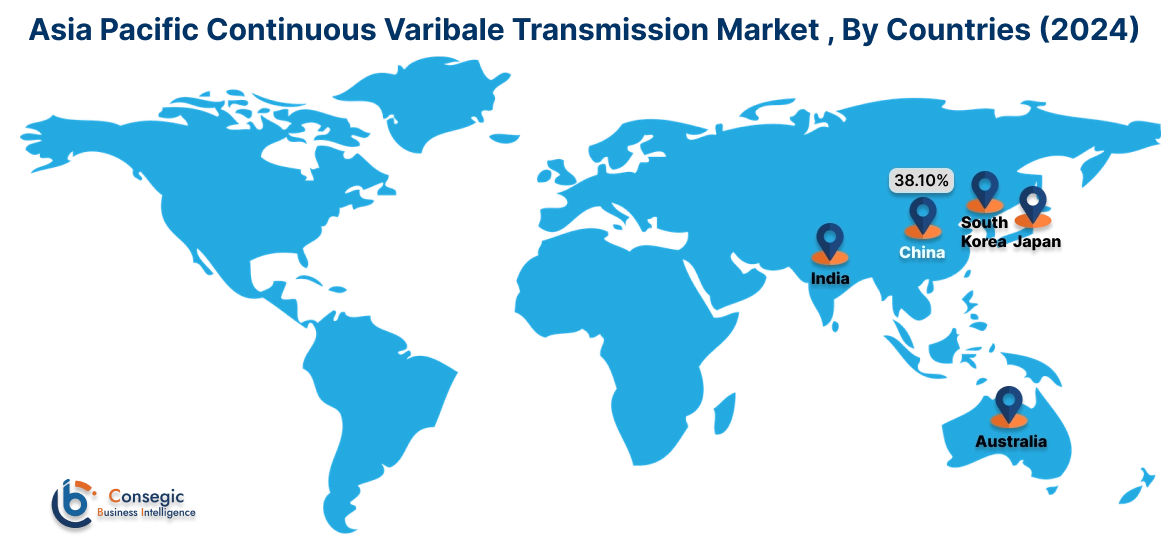
North America continuous variable transmission market is estimated to reach over USD 12.74 billion by 2032 from a value of USD 8.07 billion in 2024 and is projected to grow by USD 8.47 billion in 2025. The regional development is driven by a strong need for automatic transmissions, as the majority of Americans favor vehicles with these systems. The passenger vehicle segment is anticipated to play a key role, representing a significant portion of the market due to the rising sales of electric and hybrid vehicles. Furthermore, innovations in transmission technology are improving fuel efficiency and performance, thereby facilitating market development. As the automotive sector progresses, the U. S. market is projected to see consistent progression in the upcoming years. These factors would further drive the regional continuous variable transmission market share during the forecast period.
- For instance, in August 2023, Polaris Inc. has introduced the RANGER XD 1500, equipped with the innovative Punch Powertrain variable transmission system aimed at improving the off-highway experience for users. This model belongs to Polaris's Extreme Duty class, designed for exceptional performance, durability, and comfort in challenging utility tasks.
According to the continuous variable transmission industry, the market in Europe is currently experiencing a robust growth. Germany stands as the largest automotive production and sales market in Europe. The country's premier research and development facilities, extensive industrial value chain integration, and highly skilled workforce create an exceptional automotive landscape on the global stage. This environment empowers companies to develop advanced technologies that address future mobility needs effectively. Additionally, in Latin America, consumers are progressively choosing vehicles with enhanced features, such as fuel efficiency and superior performance. This trend is fostering the adoption of modern transmission systems, including automatic, dual-clutch, and continuously variable transmissions. Additionally, as the economies of Latin American countries continue to develop, disposable incomes are increasing, allowing consumers to purchase more costly vehicles, including those with advanced transmission systems. Furthermore, governments in the Middle East & Africa region are progressively introducing stricter fuel economy and emission standards to address pollution and encourage sustainable transportation. This regulatory initiative is accelerating the adoption of fuel-efficient technologies such as variable transmission technology.
Top Key Players and Market Share Insights:
The global continuous variable transmission market is highly competitive with major players providing solutions to the national and international markets. Key players are adopting several strategies in research and development (R&D), product innovation, and end-user launches to hold a strong position in the market. Key players in the continuous variable transmission industry includes-
- Honda (Japan)
- ZF Friedrichshafen AG (Germany)
- Ford (U.S.)
- Suzuki (Japan)
- General Motors (U.S.)
- Punch Powertrain (U.S.)
- BorgWarner Inc. (U.S.)
- Schaeffler AG (Germany)
- Eaton (Ireland)
- DAIHATSU MOTOR CO., LTD. (Japan)
Recent Industry Developments :
Agreement:
- In June 2024, Punch Powertrain has secured a project for its VT3 CVT with a prominent Chinese OEM, highlighting a significant milestone in the company's expansion endeavours. Production is set to commence in 2025, with expected annual demand surpassing 100,000 units. The VT3 transmission is acknowledged for its durability, cost-effectiveness, and design versatility, rendering it appropriate for a range of applications.
Continuous Variable Transmission Market Report Insights :
| Report Attributes | Report Details |
| Study Timeline | 2019-2032 |
| Market Size in 2032 | USD 39.32 Billion |
| CAGR (2025-2032) | 5.4% |
| By Type |
|
| By Product |
|
| By Capacity |
|
| By Fuel Type |
|
| By Transmission Type |
|
| By Vehicle Type |
|
| By Region |
|
| Key Players |
|
| North America | U.S. Canada Mexico |
| Europe | U.K. Germany France Spain Italy Russia Benelux Rest of Europe |
| APAC | China South Korea Japan India Australia ASEAN Rest of Asia-Pacific |
| Middle East and Africa | GCC Turkey South Africa Rest of MEA |
| LATAM | Brazil Argentina Chile Rest of LATAM |
| Report Coverage |
|
Key Questions Answered in the Report
How big is the Continuous Variable Transmission market? +
Continuous Variable Transmission Market Size is estimated to reach over USD 39.32 Billion by 2032 from a value of USD 24.60 Billion in 2024 and is projected to grow by USD 25.85 Billion in 2025, growing at a CAGR of 5.4%from 2025 to 2032.
Which is the fastest-growing region in the Continuous Variable Transmission market? +
Asia-Pacific is the region experiencing the most rapid growth in the market. The regional growth can be attributed to the rising adoption of AMT in commercial vehicles and growing sales of passenger cars worldwide.
What specific segmentation details are covered in the Continuous Variable Transmission report? +
The continuous variable transmission report includes specific segmentation details for type, product, capacity, fuel type, transmission type, vehicle type, and region.
Who are the major players in the Continuous Variable Transmission market? +
The key participants in the market are Honda (Japan), ZF Friedrichshafen AG (Germany), Punch Powertrain (U.S.), BorgWarner Inc. (U.S.), Schaeffler AG (Germany), Eaton (Ireland), DAIHATSU MOTOR CO., LTD. (Japan), Ford (U.S.), Suzuki (Japan), General Motors (U.S.), and others.
